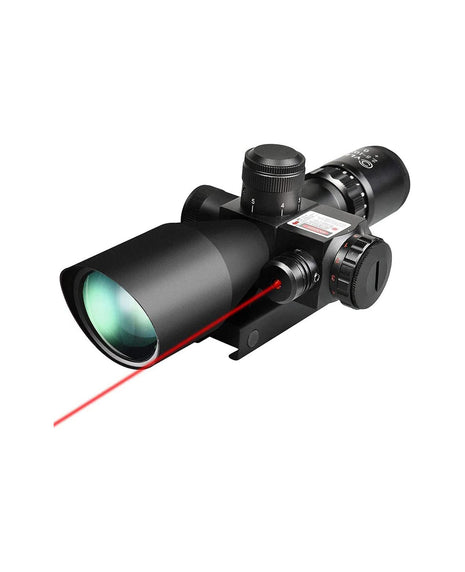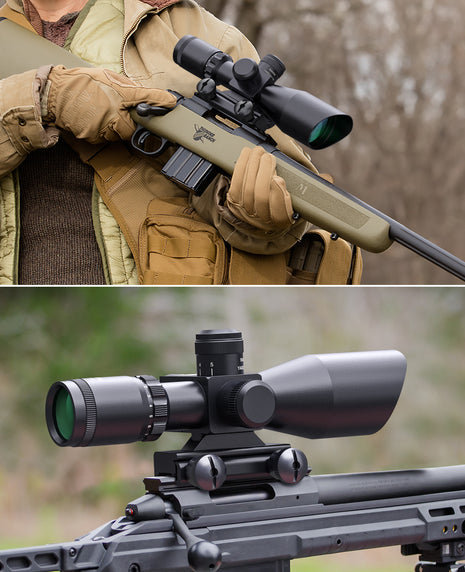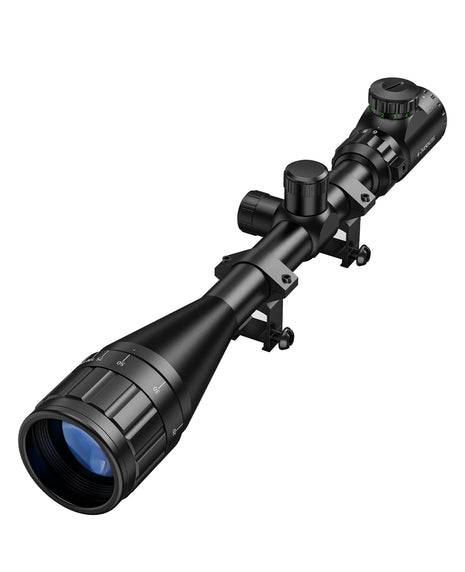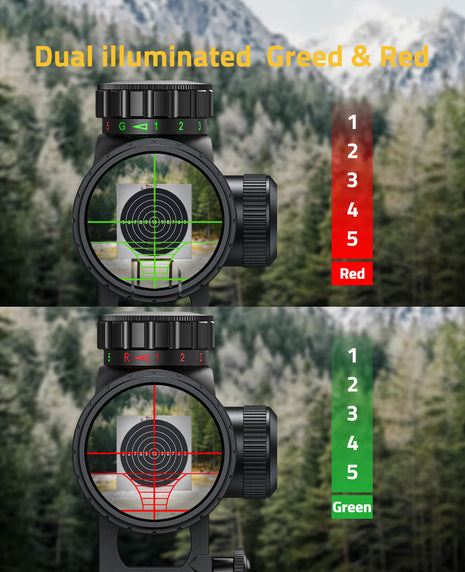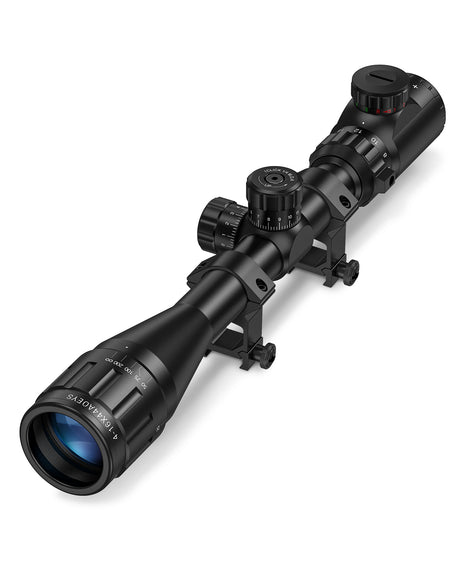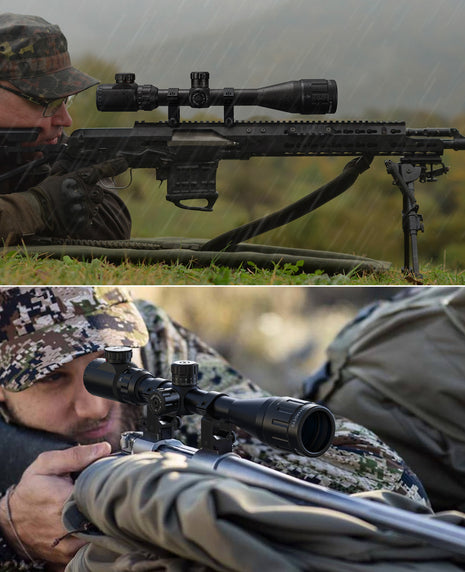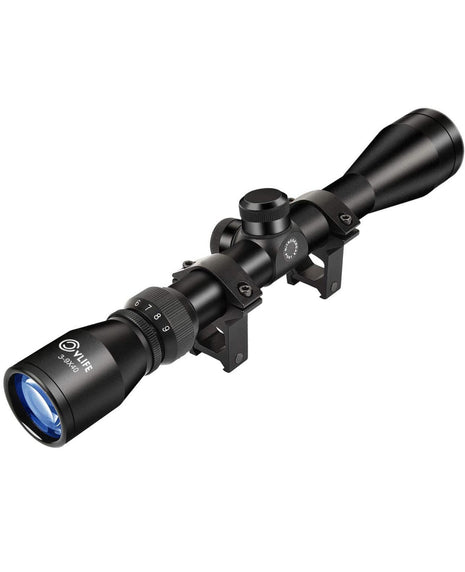How to Use Adjustable Objective Rifle Scopes?
- 6 min reading time

Adjustable objective (AO) rifle scopes have become essential for hunters and shooting enthusiasts who seek precision and accuracy. These scopes enhance accuracy by allowing parallax adjustments, especially at various shooting distances, giving the shooter a sharper image and a more precise aim. In this guide, we'll explore everything you need to know about using an AO rifle scope effectively—from choosing the right scope to mastering adjustments for optimum results.
Understanding Adjustable Objectives (AO) and Their Benefits
The adjustable objective (AO) feature allows a shooter to correct parallax error, which is the visual shift that occurs when the reticle and target appear to move relative to each other. Parallax is especially noticeable when aiming at longer distances, typically above 50 yards, and can affect shot accuracy. AO scopes, like the CVLIFE Jackalhowl 4-12x50 AO SFP Scope, come with an adjustable ring on the front, which helps eliminate this parallax by aligning the reticle with the target.
This feature is invaluable for hunters and long-range shooters. Imagine spotting a target at a distance of 200 yards but not being able to get a clear image due to parallax distortion. With an AO scope, you can adjust the objective lens for clarity and accuracy, ensuring that your reticle remains true to the target position, no matter your head position. This is critical in competitive shooting and hunting, where slight misalignment can make a huge difference.
Components of an AO Scope
Before diving into adjustments, it’s crucial to understand the different components of an AO scope, as each plays a vital role in your shooting experience.
- Objective Lens: The larger front glass element of the scope. A bigger objective lens brings in more light, which results in a brighter image. In an AO scope, the adjustment ring is located around this lens, making it easy to control parallax based on distance.
- Parallax Adjustment Knob: Found on the front near the objective lens, this knob lets you set the parallax correction to match the target’s distance. Most AO scopes have markings for common distances, like 50, 100, and 200 yards, making adjustments straightforward.
- Reticle: The reticle, or crosshair, is the aiming point you see when looking through the scope. In an AO scope, parallax adjustments ensure that the reticle aligns perfectly with the target. This way, even slight head movements won’t alter your point of aim.
- Magnification Ring: Found on variable-power scopes, the magnification ring allows you to zoom in or out. For an AO scope, using lower magnification can improve brightness in low light and make adjustments easier at different distances.
How to Adjust the Objective for Different Distances
Most AO scopes have a rotating adjustment ring near the objective lens, allowing you to adjust parallax correction based on the shooting distance. Follow these steps for effective use:
- Estimate or Measure Distance: Knowing the distance to your target is essential for accurate parallax adjustment. Use a rangefinder if available, or rely on markings on the AO ring.
- Set the Parallax: Rotate the AO adjustment ring to match your shooting distance. For example, if your target is at 100 yards, set the ring to 100 yards. This adjustment reduces parallax error, ensuring the target and reticle are on the same focal plane.
- Fine-Tune the Focus: Once you’ve set the AO adjustment, look through the scope and make small changes to focus until the target image appears sharp and clear.
- Adjust Reticle Focus if Needed: Some scopes offer an eyepiece focus adjustment to fine-tune the reticle. Ensure that both the target and reticle are sharp for the clearest shot.
With these steps, you’ll have a parallax-free, precise view of your target, reducing aiming inconsistencies and enhancing accuracy.
Practical Tips for Using AO Scopes in the Field
Mastering AO adjustments takes practice, especially in field conditions where lighting, weather, and distance vary. Here are a few practical tips:
- Check the Lighting: If shooting in low-light conditions, like dusk or dawn, lower magnification helps brighten the image.
- Practice with Different Distances: Familiarize yourself with the scope’s adjustments by shooting at different ranges to get comfortable with the AO settings.
- Use a Rangefinder: Knowing the exact distance helps you set parallax more precisely, increasing your shot accuracy.
- Recheck Adjustments: Periodically check your AO settings while in the field, especially if you change shooting positions or target distances.
Recommended Adjustable Objective Scopes from CVLIFE
CVLIFE offers a range of AO scopes that balance durability, performance, and price. The Jackalhowl 6-24x50 AO SFP Scope is designed for long-range precision with adjustable parallax and high magnification. Its large 50mm objective lens ensures clarity and brightness, even in dim light. This scope is perfect for long-range hunters or those looking to increase accuracy at various distances.
Common Challenges and Solutions with AO Scopes
Using an AO scope can come with challenges, especially for beginners. Here are a few solutions:
-
Issue: Difficulty in finding a clear target image.
Solution: Adjust the AO ring precisely. Start by setting the scope’s parallax to the target range, then fine-tune as needed for a clear image. -
Issue: Blurry reticle when adjusting for longer ranges.
Solution: Use lower magnification and fine-tune the parallax setting for clearer focus. -
Issue: Eye fatigue from constant adjustments.
Solution: Practice to build familiarity with settings. Over time, adjustments will become quicker and more intuitive.
FAQs
How often should I adjust the objective on my AO scope?
Whenever you change target distances significantly, re-adjusting the AO is recommended for the best accuracy.
Is an AO scope necessary for all shooting distances?
For shorter distances, especially under 50 yards, an AO scope is less crucial. It’s more valuable for mid- to long-range shooting.
Can I use an AO scope in low light?
Yes, but lower magnifications will give you the best image brightness in dim conditions. Choosing a scope with a larger objective lens also helps in low light.
With these insights and tips, you’re well on your way to mastering adjustable objective rifle scopes. Happy shooting!
For more tips and products, check out our full range of rifle scopes on our rifle scope collection page.
Tags
You May Also Like
Blogs & News
-

, by C V How to Use BDC Holdovers for Different Bullet Weights?
-

, by C V Is a 1-6x BDC Scope Better Than a 3-9x for AR-15?
-

, by C V How to Zero an AR-15 Scope with a BDC Reticle
-

, by C V What Makes Motion Awake Red Dot Sights Unique

